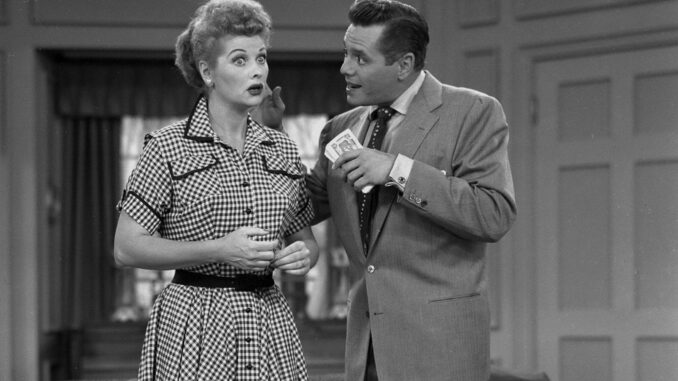
The beloved sitcom I Love Lucy set milestones in the Golden Age of Television. It was the foundation for comedies to follow, and Lucille Ball was the first woman to appear pregnant on a major television network. But one thing I Love Lucy never accomplished was shooting its own episodes in color.
Colorized television shows began to rise in popularity after I Love Lucy’s six-season run from 1951 to 1957, but the iconic sitcom never jumped on this trend. About halfway through its run, star and producer Desi Arnaz wanted to shoot an episode in color but was declined by CBS. Turns out, it was just a budgeting conflict.
Why I Love Lucy Never Shot in Color
With colorized television being all the rage in the 1950s, of course one of the most popular sitcoms wanted to jump onboard. There would be fear that I Love Lucy would be left in the dust as other shows soared because they weren’t in black and white. But CBS was reportedly concerned that shooting I Love Lucy in color would cost too much. Shooting in color would mean double what it would cost shooting in black and white, so they prohibited the new way of filming television.Since then, though, several episodes have been colorized. The first episode that was colorized was the Christmas special that many believed to be lost until 1989. In the following holiday season in 1990, CBS aired the Christmas special with flashbacks in black and white, and present day scenes in color. Other episodes that have aired in color include “Lucy Goes to Scotland” (the first episode to be fully colorized in 2007) and “Lucy’s Italian Movie.” These episodes and more can be bought as part of a colorized collection DVD set. It wasn’t until 1963 when Arnaz finally got his wish and the spinoff The Lucy Show began shooting in color.
I Love Lucy Was a Pioneer in Other Areas
While I Love Lucy missed out on shooting in color in such a trailblazing era of television, it did excel in other ways. The series was the first to use a multi-camera setup and a live studio audience, which became standard for most sitcoms that followed. The multi-cam setup even inspired Forrest Gump’s iconic park bench scenes.
There may have been worry that I Love Lucy would fall behind by sticking to black and white, but Lucy’s influential legacy proves otherwise. I Love Lucy’s lack of color doesn’t define its success; rather, it’s the endearing story of love and friendship between quirky characters who fall into exaggerated schemes. Perhaps it was better off not blowing the budget trying to shoot in color since the colorizing process was still so new to the industry. in this case, its distracting look could’ve steered viewers away from it. At the end of the day, Lucy and her antics were better off with no color.
